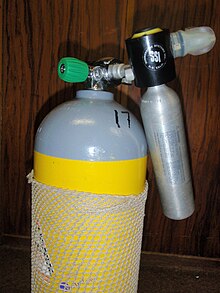Bailout bottle

Filling a spare air bailout cylinder
|
|
| Other names | Bailout cylinder, emergency gas supply |
|---|---|
| Uses | Emergency supply of breathing gas |
| Related items | Pony bottle |
A bailout bottle (BoB) or bailout cylinder is a scuba cylinder carried by an underwater diver for use as an emergency supply of breathing gas in the event of a primary gas supply failure. A bailout cylinder may be carried by a scuba diver in addition to the primary scuba set, or by a surface supplied diver using either free-flow or demand systems. The bailout gas is not intended for use during the dive except in an emergency. The term may be used to refer to just the cylinder, or the bailout set or emergency gas supply (EGS), which is the cylinder with the gas delivery system attached.
In solo diving, a buddy bottle is a bailout cylinder carried as a substitute for an emergency gas supply from a diving buddy.
Rebreathers also have bailout systems, often including an open-circuit bailout bottle.
For scuba, a "bailout bottle" or "self-contained ascent bottle" is a small diving cylinder meant to be used as an alternate air source to allow a controlled ascent with any required decompression, in place of a controlled emergency swimming ascent, which will not allow required decompression. A bailout cylinder is required equipment for a professional diver using scuba in some circumstances.
A pony bottle is an example of a small bailout cylinder which has a standard diving regulator with first and second stages. There are also significantly smaller cylinders which have the first stage — and in the smallest models also the second stage — integrated into the cylinder valve itself. A well-known example of this class of bailout bottle is the "Spare Air" set, which can supply a few breaths to allow the diver to ascend at a safe rate, but not enough to do a decompression stop. This type of bailout bottle is typically carried in a holster that is attached to the diver's harness.
"Spare Air" bailout bottles, introduced in the 1980s, are very small cylinders with integral scuba regulators. Their disadvantage is that in many emergency situations they do not have sufficient capacity to get a diver back to the surface safely, and thus may cause divers carrying them to feel an unjustified sense of safety. Their advantage is that they are compact and easy to deploy, and that a small amount of air is better than none in an emergency.
A review carried out by Scuba Diving magazine attempted to give a sense of from what depth bailout bottles of various capacities could get divers to the surface under maximum safe ascent rates, though the review cautioned that the reviewers were in controlled conditions and thus could not replicate the circumstances of an actual panicked diver. The review found that a 1.7-cubic-foot (0.24 L) bottle had sufficient air to get the reviewing diver from 45 feet (14 m) to the surface; a 3-cubic-foot (0.4 L) bottle from a depth of 70 feet (21 m); and a 6-cubic-foot (0.8 L) bottle from the maximum reviewed depth of 132 feet (40 m), which is the maximum depth recommended for recreational dives by some training agencies. A bell diver must be able to return to the bell on the contents of the bailout cylinder, which will be influenced by the depth and umbilical length, and limited by the size of the bell entry lock manway.
...
Wikipedia
